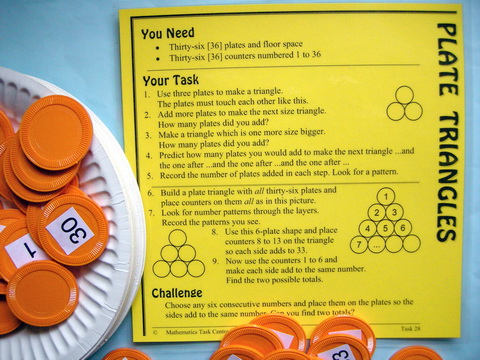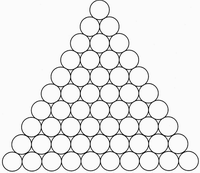
Plate TrianglesTask 28 ... Years 4 - 8SummaryThis task needs floor space to lay out an 8-plate equilateral triangle. In the beginning plates are used to represent objects arranged in a triangle. Counting in each row generates the Natural Numbers and counting the total of plates from the beginning to the current row generates the Triangle Numbers. Now the explorations begin. Place the counters on the plates in order and look for patterns, or try the Triangle Teasers, or use the number patterns in other problems.This cameo includes an Investigation Guide. |
Materials
Content
|

IcebergA task is the tip of a learning iceberg. There is always more to a task than is recorded on the card. |
The task highlights visually and kinaesthetically that the Triangle Numbers are formed by adding consecutive Natural Numbers from 1, ie:
3 2 5 1 6 Solving Question 10, which has more clues, provides another piece of data about Triangle Teasers ... and raises more questions:
|

|
Note: A large version of the picture on the left can be used to build a recording sheet for the students. Click on the picture to show a large version on screen, then right click (click and hold in Mac) to reveal a menu which will allow you to save the picture to your computer. Create your record sheet by inserting the picture into a word processing document. (A large PDF version is available in the Maths At Home link below). |
Note: This investigation has been included in Maths At Home. In this form it has fresh context and purpose and, in some cases, additional resources. Maths At Home activity plans encourage independent investigation through guided 'homework', or, for the teacher, can be an outline of a class investigation.
- Visit the Home Page for more Background.
- For this specific activity click the Learners link and on that page use Ctrl F (Cmd F on Mac) to search the task name.
Whole Class InvestigationTasks are an invitation for two students to work like a mathematician. Tasks can also be modified to become whole class investigations which model how a mathematician works. |
The paper plates make a great public display on your floorboard. The class can gather around and all be involved by having a plate each to include one by one as the rows are built.
Hand out another (perhaps different colour) plate to each student. Ask them to use a marker pen to trace the circumference of the base of the plate (just inside the frilly bit). Then assign each student a number and ask them to use the marker to write that number as big as possible in the circle. Provide scissors so they can carefully cut away the frilly bit. 28 students implies 28 numbers and a 7 row triangle. Fast finishers can easily supply the extra 8 numbers (20 - 36) to allow you to explore the number patterns and puzzles suggested in the task. There is a good chance your art teacher will be happy to receive the frilly cut aways. At this stage, Plate Triangles does not have a matching lesson on Maths300. Visit Plate Triangles on Poly Plug & Tasks. |
Is it in Maths With Attitude?Maths With Attitude is a set of hands-on learning kits available from Years 3-10 which structure the use of tasks and whole class investigations into a week by week planner. |
The Plate Triangles task is an integral part of:
|